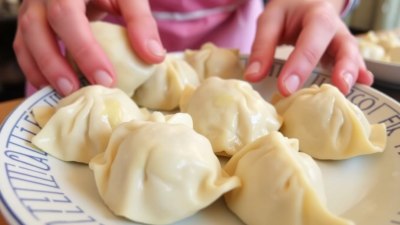Warsaw's Pierogi Making Classes: Learning Polish Culinary Traditions
Discover the joy of making pierogi in Warsaw, explore Polish culinary traditions, and enjoy a delightful cooking experience.

Image created with Flux Schnell
Poland is famous for many culinary delights, but none are quite as iconic as pierogi. These delicious dumplings have captured the hearts of food lovers around the world, and there is no better place to learn how to make them than Warsaw, the capital city of Poland. In this article, we will explore the rich tradition of pierogi making, the best classes available in Warsaw, and tips for mastering this beloved dish.
The History of Pierogi
To truly appreciate pierogi, it’s important to understand their history. Pierogi are thought to have originated in the 13th century, with fried dumplings appearing in Western European cuisine that would later influence the Polish version. Initially, these dumplings were made as a way to preserve food — the fillings varied widely, from potatoes, cheese, and meats to fruits and sweets.
Throughout the centuries, pierogi became a staple in Polish households, serving as a hearty meal for families. They’ve evolved from a simple dish to a culinary symbol of Polish culture. Today, they hold a special place in Polish weddings, Christmas celebrations, and indeed every family gathering, showcasing the importance of tradition in Polish cuisine and hospitality.
The Significance of Pierogi Classes
Pierogi making classes in Warsaw offer a unique culinary experience that goes beyond ordinary cooking. These classes not only teach the basic techniques of preparing pierogi but also immerse participants in the rich tapestry of Polish culture and heritage. By attending a class, you can engage with local chefs, learn about secret family recipes, and gain hands-on experience in making these dumplings.
Moreover, cooking classes provide an opportunity to connect with local people and fellow travelers who share your passion for food. Engaging in a communal cooking experience also reflects the essence of Polish hospitality, where sharing a meal brings people together.
Where to Take Pierogi Classes in Warsaw
With an array of culinary schools and cooking workshops in Warsaw, it can be difficult to choose the right one for you. Here are some top-rated classes where you can learn to make authentic pierogi:
1. The Cook Up
The Cook Up offers interactive hands-on pierogi-making sessions in a cozy, welcoming environment. Under the guidance of skilled chefs, you will learn the art of dough preparation, filling selection, and cooking methods to create perfect pierogi. Classes usually last for about three hours and end with a delightful tasting session where you can enjoy your creations together with the group.
2. Taste of Poland
Taste of Poland provides a unique culinary exploration complemented by the history of Polish cuisine. Their pierogi classes cover traditional fillings and modern variations, enabling participants to explore their creativity. In addition to making pierogi, you also learn about their cultural significance and how to pair them with traditional Polish sauces.
3. Pierogi & Co.
For a more immersive experience, Pierogi & Co. combines cooking classes with guided tours of local markets. This unique approach allows you to understand ingredient selection while also learning how to make delicious pierogi. The class allows you to gain knowledge about where to find the best ingredients, and of course, the best part is enjoying your fresh pierogi at the end of the session.
Choosing the Right Class for You
When selecting a class, consider your skill level and what you hope to achieve. Whether you are a beginner eager to learn the basics or an experienced cook looking to refine your skills, there is a class suited to your needs. Look for reviews and check out the details of each class to ensure it aligns with your culinary interests.
What to Expect During a Pierogi Making Class
Typically, pierogi classes begin with a brief introduction where the instructor shares the history and culture surrounding the dish. You will then dive into making the dough from scratch, a crucial step that sets the foundation for your pierogi. Learning the right technique for rolling the dough to the perfect thickness is essential for achieving desirable textures that are both tender and hearty.
Next, you will learn how to prepare various fillings. Traditional options include potato and cheese, sauerkraut, mushroom, and meat. Many classes also encourage you to experiment with creative fillings like spinach and feta or sweet options like blueberry and ricotta, showcasing how versatile the pierogi can be.
Cooking Methods
Once filled, your pierogi are ready for cooking! In most classes, you will boil the pierogi first, which enhances their flavor and texture. After boiling, students may also have the opportunity to pan-fry the pierogi in butter until golden brown, adding a lovely crisp exterior that complements the soft interior.
The Tasting Experience
No pierogi class is complete without indulging in the fruits of your labor. After cooking, you’ll gather around the table, share stories, and taste the delicious creations while enjoying traditional Polish toppings such as sour cream, fried onions, or fresh herbs. This communal experience not only enhances your appreciation of the dish but also fosters a sense of camaraderie among participants.
Cooking Tips for Perfect Pierogi
Aside from participating in a class, here are some valuable tips to bear in mind while making pierogi at home:
1. Use high-quality ingredients: Fresh, high-quality ingredients make all the difference when it comes to flavor.
2. Don’t rush the dough: Knead the dough until it’s smooth and elastic; this will help it hold its shape during cooking.
3. Roll thinly but evenly: Rolling out the dough to an even thickness ensures that the pierogi cook thoroughly.
4. Seal well: Make sure to seal the edges tightly to prevent the filling from leaking out during cooking.
5. Don’t overcrowd the pot: When boiling, cook only a few pierogi at a time to avoid them sticking together.
Warsaw’s pierogi making classes are a fantastic way to embrace Polish culinary traditions while creating meaningful connections through food. Whether you’re a local or a traveler in Poland, these classes offer a delightful way to learn, create, and enjoy one of your favorite dishes in a heartwarming and communal setting. So, roll up your sleeves, dust off your apron, and get ready for an unforgettable culinary experience that captures the spirit of Poland.
Join a Pierogi Class Today!
If you’re eager to try your hand at making pierogi, many classes provide online booking options. Take the first step in your culinary journey today and immerse yourself in the delicious world of Polish dumplings!











